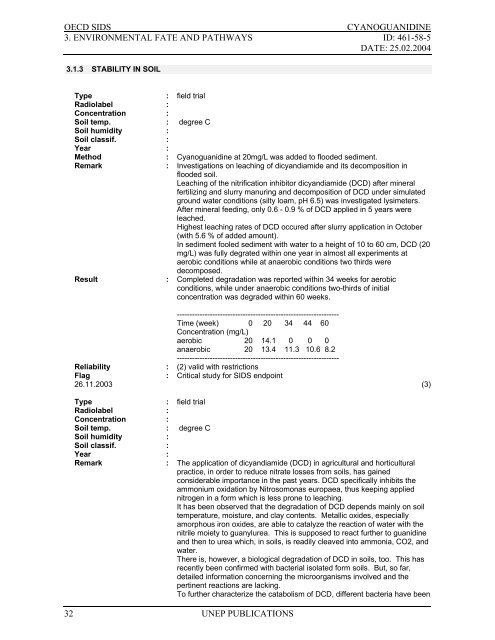Cyanoguanidine CAS N°: 461-58-5
Cyanoguanidine CAS N°: 461-58-5
Cyanoguanidine CAS N°: 461-58-5
You also want an ePaper? Increase the reach of your titles
YUMPU automatically turns print PDFs into web optimized ePapers that Google loves.
OECD SIDS<br />
CYANOGUANIDINE<br />
3. ENVIRONMENTAL FATE AND PATHWAYS ID: <strong>461</strong>-<strong>58</strong>-5<br />
DATE: 25.02.2004<br />
3.1.3 STABILITY IN SOIL<br />
Type : field trial<br />
Radiolabel :<br />
Concentration :<br />
Soil temp. : degree C<br />
Soil humidity :<br />
Soil classif. :<br />
Year :<br />
Method : <strong>Cyanoguanidine</strong> at 20mg/L was added to flooded sediment.<br />
Remark : Investigations on leaching of dicyandiamide and its decomposition in<br />
flooded soil.<br />
Leaching of the nitrification inhibitor dicyandiamide (DCD) after mineral<br />
fertilizing and slurry manuring and decomposition of DCD under simulated<br />
ground water conditions (silty loam, pH 6.5) was investigated lysimeters.<br />
After mineral feeding, only 0.6 - 0.9 % of DCD applied in 5 years were<br />
leached.<br />
Highest leaching rates of DCD occured after slurry application in October<br />
(with 5.6 % of added amount).<br />
In sediment fooled sediment with water to a height of 10 to 60 cm, DCD (20<br />
mg/L) was fully degrated within one year in almost all experiments at<br />
aerobic conditions while at anaerobic conditions two thirds were<br />
decomposed.<br />
Result : Completed degradation was reported within 34 weeks for aerobic<br />
conditions, while under anaerobic conditions two-thirds of initial<br />
concentration was degraded within 60 weeks.<br />
----------------------------------------------------------------<br />
Time (week) 0 20 34 44 60<br />
Concentration (mg/L)<br />
aerobic 20 14.1 0 0 0<br />
anaerobic 20 13.4 11.3 10.6 8.2<br />
----------------------------------------------------------------<br />
Reliability : (2) valid with restrictions<br />
Flag : Critical study for SIDS endpoint<br />
26.11.2003 (3)<br />
Type : field trial<br />
Radiolabel :<br />
Concentration :<br />
Soil temp. : degree C<br />
Soil humidity :<br />
Soil classif. :<br />
Year :<br />
Remark : The application of dicyandiamide (DCD) in agricultural and horticultural<br />
practice, in order to reduce nitrate losses from soils, has gained<br />
considerable importance in the past years. DCD specifically inhibits the<br />
ammonium oxidation by Nitrosomonas europaea, thus keeping applied<br />
nitrogen in a form which is less prone to leaching.<br />
It has been observed that the degradation of DCD depends mainly on soil<br />
temperature, moisture, and clay contents. Metallic oxides, especially<br />
amorphous iron oxides, are able to catalyze the reaction of water with the<br />
nitrile moiety to guanylurea. This is supposed to react further to guanidine<br />
and then to urea which, in soils, is readily cleaved into ammonia, CO2, and<br />
water.<br />
There is, however, a biological degradation of DCD in soils, too. This has<br />
recently been confirmed with bacterial isolated form soils. But, so far,<br />
detailed information concerning the microorganisms involved and the<br />
pertinent reactions are lacking.<br />
To further characterize the catabolism of DCD, different bacteria have been<br />
32<br />
UNEP PUBLICATIONS
















